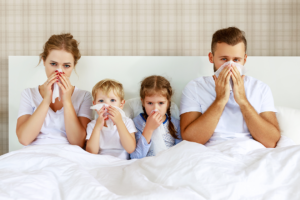 Do Viral Comparisons of Influenza (Flu) and COVID-19 Help?
Do Viral Comparisons of Influenza (Flu) and COVID-19 Help?
It is commonly known that both Influenza and COVID-19 are viral infections, but most people aren’t aware of their similarities and differences beyond that. I’ll try to shed some light on that topic here. For starters, a different virus causes each condition. An infection from a viral strain known as SARS-CoV-2 (the new coronavirus) causes Covid-19, while infection from influenza viruses causes the flu. Both are contagious respiratory illnesses with similar signs and symptoms. This makes it hard to tell the difference between them based on symptoms alone. A change in sense of taste or smell, or the loss of taste or smell entirely, seems to be the biggest difference in signs and symptoms between COVID-19 and flu. However, not everyone experiences these changes. Therefore, the best way to determine the difference is to get tested. Unfortunately, even this is not a perfect science. There can be false positives (meaning the test result is positive when the person does not have the infection) and false negatives (meaning the test result is negative when the person does have the infection).
Both COVID-19 and flu can result in severe illness and complications in high-risk populations such as pregnant women, older adults, and people with certain underlying medical conditions such as heart disease, respiratory conditions, obesity, cancer, immune deficiency disorders, and diabetes. Viral comparisons can help us understand complication risks. The risk of complications for healthy children is higher for flu compared to COVID-19, but children with underlying medical conditions are at increased risk for both flu and COVID-19.
Expert opinions warn that co-infection with influenza and Covid-19 has the potential to be devastating to patients and our healthcare system during the upcoming flu season. A preliminary analysis led by Ian Brown, MD at Stanford University School of Medicine shows that about 1-in-5 people with Covid-19 are also infected with other respiratory illnesses. It also shows that about 1-in-10 people that are diagnosed with common respiratory viruses are infected with Covid-19. It is important to underscore that patients diagnosed with influenza, respiratory syncytial virus, and other common viruses this fall and winter may also be co-infected with Covid-19. Per government health agencies, it is strongly encouraged for people to receive their influenza vaccine this year, as the benefit of receiving the influenza vaccine has been shown to outweigh the extremely low risk of side effects, in spite of varying effectiveness of the vaccine from year to year. Even with an influenza vaccine, it is important to keep in mind that the best prevention during this time is frequent hand washing, not touching your face, social distancing, and eating a diet filled with nutrients to support your body’s normal functions.
Comparing SARS, COVID-19, and the Common Cold
Viral comparisons can help us learn much. The main similarity between SARS, COVID-19, and some of the most common viruses responsible for the common cold is that they are in the coronavirus family. The coronavirus family can cause mild infections like the common cold, but it can also lead to life-threatening infections. Severe acute respiratory syndrome (SARS) had a 10% fatality rate in 2002, and Middle East Respiratory Syndrome (MERS) had a 35% fatality rate in 2012. From the beginning of the Covid-19 pandemic, the fatality rates for Covid-19 have been all over the map. They have ranged from less than 1% to as much as 25% in some countries. The reason for this goes back to something I mentioned in part 1, “valid analysis of valid data is everything.” It is often at the discretion of those responsible for disseminating information to choose their sources of data, which can lead to conflicting reports.
Comparing COVID-19 and Allergies
Transitions between seasons coupled with the heightened awareness of Covid-19 lends extra weight to every sneeze, cough, or tickle in the throat… Do I have COVID-19? For those with allergies, this question becomes a little more complex — Are my allergies kicking in? Is it COVID-19, or perhaps something else?
Viral comparisons can help us understand responses to different conditions. Allergy symptoms range from mild to severe. They can occur seasonally or be present year-long. In patients with asthma, allergies can cause coughing, wheezing, and shortness of breath. Allergies are not contagious. They are caused by your immune system overreacting to normal irritants in the environment, like pollen, dust, mold, or pet dander. Sneezing, stuffy nose, itchy or watery eyes, itchy nose or ears, post-nasal drip (which can sometimes cause a mild sore throat), mild fatigue, and other allergy-related symptoms can typically be treated with medications.
COVID-19 is spread through droplets via coughing, sneezing, and close personal contact. Symptoms typically start between 2-14 days after exposure and will typically resolve within 14 days after onset, whether the symptoms are mild, moderate, or severe. Common Covid-19 symptoms include fever, dry cough, shortness of breath, intense fatigue, body aches, and loss of taste or smell.
When symptoms associated with COVID-19 are present, it can quickly lead to anxiety, especially considering the current state of public health concerns revolving around the pandemic. The key points to remember are timeline and past history. People with allergies often have a history of seasonal allergies, and these symptoms tend to run longer than viral symptoms. Allergies respond to allergy medications, so rapid and noticeable response to these medications is an easy way to rule out COVID-19 as a culprit. While conjunctivitis and clear watery discharge can be symptoms of COVID-19, they are not usually accompanied by itchiness as they are in allergies. People with allergies do not develop fevers, and Covid-19 typically does not cause wheezing. Lastly, those with allergies often have coexisting asthma, which can lead to coughing, shortness of breath, chest tightness, and wheezing.
Below is a list of the most common symptoms that can be used to do viral comparisons with Covid-19, allergies, flu, and the common cold. Please understand that this is not an exhaustive list, but it is a good starting point. In the final article in this series, we will talk about how to help keep your immune system healthy as we transition into Cold and Flu/COVID-19 Season. Stay tuned for part 3.
| SYMPTOMS | ALLERGIES | COLD | COVID-19 | FLU |
| BODY ACHES | Rarely | √ | √ | √ |
| CHILLS | No | No | √ | √ |
| FEVER | No | Rarely | √ | √ |
| HEADACHE | Sometimes | Sometimes | Sometimes | Sometimes |
| NASAL CONGESTION | √ | √ | Rarely | Rarely |
| RUNNY NOSE | √ | √ | Rarely | Rarely |
| SNEEZING | √ | √ | Rarely | Rarely |
| ITCHY/WATERY EYES | √ | No | No | No |
| DRY COUGH | Sometimes | √ | √ | √ |
| SHORTNESS OF BREATH | Sometimes | Sometimes | √ | √ |
| WHEEZING | Sometimes | Sometimes | √ | √ |
| LOSS OF SMELL OR TASTE | Mild | Rarely | Sometimes | Rarely |
| SORE THROAT | Sometimes | √ | Sometimes | Sometimes |
| NAUSEA, VOMITING, DIARRHEA | No | Sometimes | Sometimes | Sometimes |
1 Woloshin S, Patel N, Kesselheim AS. False Negative Tests for SARS-CoV-2
Infection – Challenges and Implications. N Engl J Med. 2020;383(6):e38.
2 Greenberg, S. B. Update on Human Rhinovirus and Coronavirus Infections. Semin.
Respir. Crit. Care Med. 37, 555–571 (2016).
If you like this, you’d also like:


